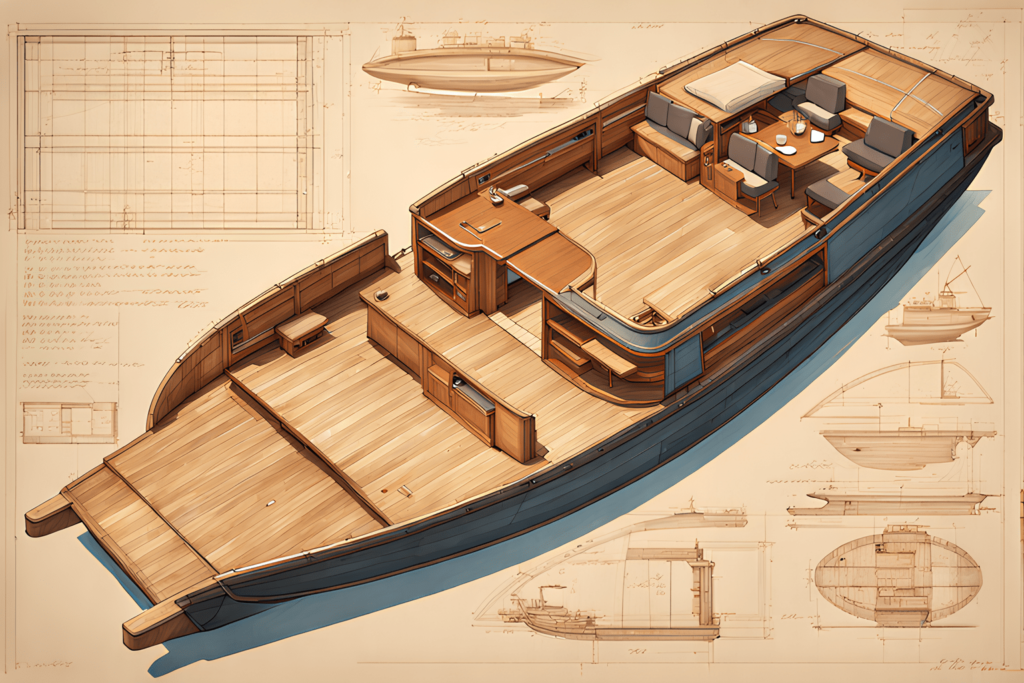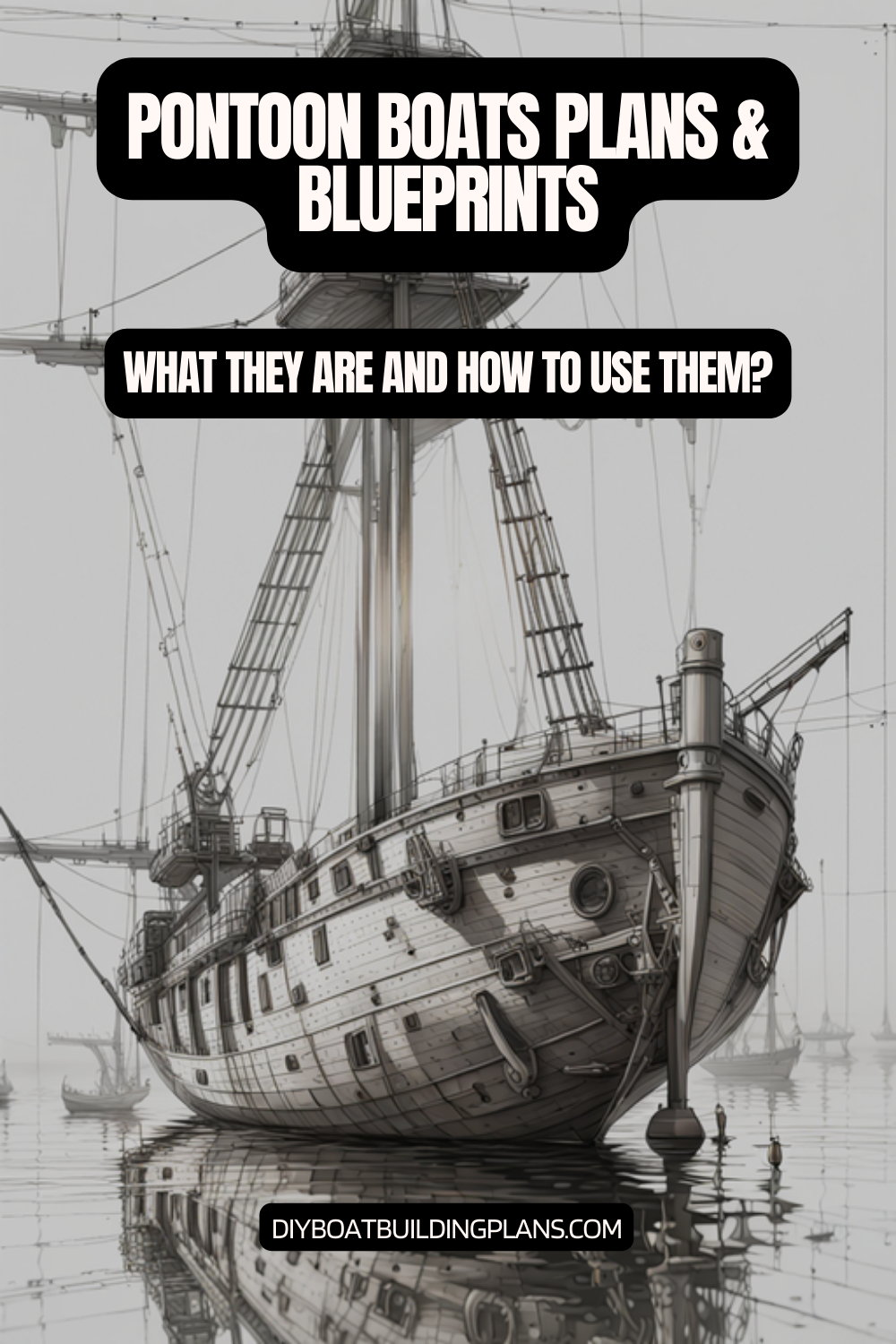Ever dreamed of making your own watercraft that fits your lifestyle and budget? What if building a pontoon boat was easier than you thought?
DIY pontoon boat plans let enthusiasts turn their boating dreams into reality. For just $15.95, you can get detailed blueprints. This makes building a custom boat possible for both new and experienced builders.
Whether you love fishing, enjoy weekend trips, or seek adventure, homemade pontoon boat designs are perfect. These plans let you build a boat that shows off your style while saving money compared to buying one.
Key Takeaways – Pontoon Boat Plans & Blueprints
- DIY pontoon boat plans are affordable and accessible
- Custom boat designs offer personalized water experiences
- Building your own boat can save substantial money
- Blueprints available for various skill levels
- Multiple boat styles can be created using detailed plans

Understanding the Basics of Pontoon Boats
Pontoon boats are a unique blend of design, comfort, and engineering. They have changed how we enjoy the water, making it fun for families and boating fans alike.
Pontoon boats stand out with their flat bottoms and great stability. Their design lets you customize them, making them a hit with boaters.
What is a Pontoon Boat?
A pontoon boat has a flat bottom and is supported by aluminum tubes. These tubes make the boat very stable and buoyant. It’s like having a “living room on the water”.
- Flat deck design for maximum usable space
- Supported by aluminum pontoon tubes
- Highly stable and adaptable platform
Key Components of a Pontoon Boat
To build a pontoon boat, you need to know about its key parts:
| Component | Function |
|---|---|
| Pontoon Tubes | Provide buoyancy and stability |
| Deck | Primary walking and seating area |
| Frame | Structural support for boat components |
| Motor | Propulsion system |
Benefits of Building Your Own Pontoon Boat
Building your own pontoon boat is rewarding. It lets you create a boat that fits your needs perfectly.
“Building your own pontoon boat is not just a project, it’s an adventure in craftsmanship and personal expression.”
- Cost-effective alternative to purchasing
- Complete customization options
- Sense of personal accomplishment
- Opportunity to learn advanced boat-building skills
Today’s pontoon boats are very versatile. They’re great for fishing, water sports, and family fun. With the right construction, you can make a boat that’s just right for you.
Types of DIY Pontoon Boat Designs
Creating custom pontoon boat plans means knowing the special traits of each design. Each type of pontoon boat has its own purpose. This lets fans make boats that fit their needs with DIY kits.
Pontoon boats are great for water lovers because they’re so versatile. Choosing the right design depends on what you want to do, how much you can spend, and what you like.
Flat Deck Pontoon Boats
Flat deck pontoon boats are the most flexible in custom plans. They offer:
- Big open deck space
- Great stability
- Many ways to set up activities
- An easy build process
Fishing Pontoon Boats
Fishing enthusiasts love the special features of fishing pontoon boats. These boats have:
| Feature | Description |
|---|---|
| Rod Holders | Places to mount fishing rods |
| Livewells | Spaces for catching and keeping fish |
| Storage Compartments | Areas for fishing gear and tackle |
Party Pontoon Boats
Party pontoon boats are all about fun and friends. They have:
- Big seats for everyone
- Good sound systems
- Spaces for coolers
- Comfortable places to relax
“The beauty of DIY pontoon boat plans lies in their incredible adaptability to personal preferences and recreational needs.”
When looking at DIY kits, remember what materials and design you choose affect your boat’s performance and how long it lasts.
Essential Materials for Construction
Building a pontoon boat needs careful picking of materials and following construction plans. The right stuff makes a strong boat, not a safety hazard.
Starting a DIY pontoon boat project means choosing the right materials. This is key for a safe and strong boat.
Choosing the Right Materials
Pontoon boat making uses important materials:
- Aluminum pontoon tubes for durability and lightness
- Marine-grade plywood for the deck
- Galvanized steel or aluminum for the frame
- Polyethylene as a different pontoon material
“The quality of your materials determines the longevity of your boat” – Marine Engineering Experts
Tools You Will Need
Having the right tools makes building easier:
- Circular saw
- Drill and drill bits
- Measuring tape
- Welding equipment (for metal frames)
- Sandpaper and finishing tools
Safety Gear and Precautions
Always put safety first when building a boat:
| Safety Item | Purpose |
|---|---|
| Safety Goggles | Protect eyes during cutting and welding |
| Work Gloves | Prevent hand injuries |
| Respirator | Protect from dust and chemical fumes |
| Ear Protection | Reduce noise from power tools |
Pro tip: Always check local boat building rules and make sure the boat is balanced for safety.
Your construction plans will tell you what materials you need for your design. Spend time finding top-notch materials that can handle the sea.
Step-by-Step Guide to Building a Pontoon Boat
Starting a pontoon boat project needs careful planning and detail. Pontoon boat assembly requires precision and patience. This guide will help you build your own watercraft step by step.
Before starting, collect all needed materials. Also, set up a workspace that’s safe and comfortable for building.
Planning Your Build
Good planning is key to a successful pontoon boat. Consider these important points:
- Measure and sketch your boat design
- Choose the right materials
- Plan how long it will take (40-60 hours)
- Set a budget for materials (about $300)
Cutting and Assembling the Frame
The frame is the heart of your pontoon boat. This stage needs careful attention.
- Cut pressure-treated lumber to the right size
- Use galvanized straps for strong connections
- Make sure it’s sturdy and balanced
- Double-check all joints and connections
“Measure twice, cut once” – A key rule in boat building
Adding the Deck and Finishing Touches
The last step is making a deck that’s both functional and comfy. Use exterior-grade plywood (4 sheets) and think about adding special features like storage or seats.
- Apply 8 yards of bidirectional fiberglass cloth
- Use 1.5 gallons of polyester resin for waterproofing
- Plan for about 10 hours of painting
With careful work, you’ll turn raw materials into a beautiful pontoon boat ready for fun on the water.
Important Considerations Before You Start
Starting a pontoon boat DIY project needs careful planning. Knowing the key factors helps you build your dream boat successfully.
Budgeting for Your Project
Building a pontoon boat requires smart financial planning. When looking at DIY kits, remember these budget points:
- Material costs range from $2,000 to $5,000
- Tool expenses for specialized equipment
- Additional accessories and finishing materials
- Potential unexpected project expenses
“Proper financial preparation is the foundation of a successful boat-building project.”
Storage and Transport Options
Choosing the right storage and transport is key for your project. Think about these important points:
| Storage Option | Pros | Cons |
|---|---|---|
| Boat Trailer | Mobility, easy storage | Additional purchase cost |
| Boat Lift | Protects from ground damage | Higher initial investment |
| Marina Storage | Professional handling | Ongoing monthly fees |
Local Regulations and Registration
Understanding legal needs is vital for your project. Look into local rules, which include:
- Boat registration processes
- Size and weight restrictions
- Safety equipment mandates
- Potential licensing fees
Pro tip: Contact local maritime authorities to ensure full compliance with regional boating regulations.
Finding Reliable DIY Pontoon Boat Plans
Finding the right DIY pontoon boat plans can be tough. It’s important for both new and experienced builders. The right plans make building a boat fun and successful.
- Online marine design platforms
- Specialized boat-building websites
- Professional marine architect resources
- DIY boating forums and communities
Where to Source Plans and Blueprints
Looking for quality plans takes some effort. Today, you can find lots of boat plans online. Websites with detailed guides are great resources.
“The right plans can make the difference between a challenging build and an enjoyable boat-building experience.”
Assessing the Quality of Plans
When checking out plans, look at these key points:
Download over 500 Boat Plans. Click on the link below.
-->Click Here<--
- Detailed material specifications
- Step-by-step construction instructions
- Technical drawings with precise measurements
- Support options from plan designers
Free vs. Paid Plans: What to Consider
There are free and paid plans out there. Free plans might be basic. But paid plans usually offer:
- Comprehensive technical documentation
- Advanced design specifications
- Professional support channels
- Refined construction techniques
Most builders say it’s worth spending on quality plans. Plans range from 12′ to 20′ long. They include details on hull design, materials, and how to build it.
Unlock the secrets to building your dream boat with MyBoatPlans! With detailed plans for over 518 boats and expert video tutorials, you’ll have everything you need to create your perfect vessel. Click here to begin your journey!
Tips for Customizing Your Pontoon Boat
Turning your DIY pontoon boat into a unique vessel is exciting. Custom plans let you make your boat truly yours. It’s a chance to meet your specific needs.
When designing your boat, think about these key tips. They can make your boating experience better:
Adding Seating and Comfort Features
Seating is key for comfort and function. Guides suggest looking into different options:
- Swivel fishing chairs with 360-degree rotation
- Comfortable L-shaped sunpads
- Adjustable loungers with storage underneath
- Bench seating with integrated cupholders
Incorporating Storage Solutions
Smart storage boosts your boat’s use. Here are some ideas:
- Under-seat compartments for gear and equipment
- Built-in coolers for food and beverages
- Rod storage boxes for fishing enthusiasts
- Waterproof electronic device storage
Upgrading with Electronics and Accessories
Modern pontoon boats can have cool tech upgrades:
- High-quality fishfinders like Garmin 5CV or 743XSV
- Premium sound systems
- LED lighting for evening cruises
- GPS navigation systems
“The beauty of a custom pontoon boat is that it reflects your personal style and intended use.” – Boating Enthuasiast Magazine
Don’t forget to keep performance in mind. Choose upgrades that keep your boat stable and efficient.
Maintenance and Care for Your Pontoon Boat
Keeping your pontoon boat in top shape needs your full attention and regular care. This care not only makes your boat last longer but also keeps it running well and safe on the water.
Maintaining your pontoon boat covers several key areas. These include the materials used in its construction and regular upkeep:
Routine Maintenance Tasks
- Clean the deck well with a non-skid cleaner
- Check the pontoon tubes for damage or leaks
- Flush the engine after each use, more so in saltwater
- Wax the boat every few months to keep it looking good
- Make sure drain plugs are secure to avoid water buildup
Winterization Tips
Getting your pontoon boat ready for winter needs careful steps:
- Drain all water systems completely
- Apply protective coatings to aluminum pontoons
- Store in a dry, covered spot
- Take out the battery and keep it in a warm, dry spot
- Use a breathable boat cover
Troubleshooting Common Issues
Spotting problems early can save you a lot of time and money. Keep an eye out for these common issues:
“Prevention is always better than cure when it comes to boat maintenance.”
- Watch for damage to the pontoon tubes
- Check for water in the pontoon compartments
- Regularly check the engine’s performance
- Look for corrosion, mainly on aluminum parts
- Make sure drainage and seals are working right
Remember, aluminum pontoons need special care. Regular cleaning, proper storage, and quick repairs will keep your boat looking and running great for many years.

Enjoying Your DIY Pontoon Boat Experience
Building your own pontoon boat is an exciting journey. It opens up a world of water adventures. You can create a custom watercraft that reflects your personal style and needs.
Whether you’ve crafted a compact fishing vessel or a spacious leisure boat, the real joy begins when you take your DIY creation out on the water.
Safety should always be your top priority when exploring lakes, rivers, and reservoirs with your pontoon boat DIY kits. Familiarize yourself with local boating regulations, invest in proper safety equipment, and always wear a life jacket.
Take time to understand your boat’s capabilities and limitations. This is important, even if you’ve constructed it using recycled materials like 30-gallon barrels and reclaimed wood.
Safety Tips for First-Time Users
Before launching, conduct a thorough inspection of your boat’s structural integrity. Check all connections, ensure the deck is secure, and verify that your waterproofing techniques are solid.
Practice maneuvering in calm waters first. Consider taking a basic boating safety course to boost your confidence and skills.
Best Fishing and Leisure Locations
Local reservoirs, calm lakes, and slow-moving rivers make ideal locations for your homemade pontoon boat. Research nearby water bodies that permit small watercraft, and always obtain the necessary permits and registration.
Connect with local boating communities to discover hidden gems. Get insider tips on the best fishing spots and leisure areas perfect for your unique watercraft.
Joining Pontoon Boat Communities and Clubs
Sharing your DIY pontoon boat experience can be incredibly rewarding. Look for local boating clubs, online forums, and social media groups where enthusiasts gather.
Exchange ideas, share maintenance tips, and celebrate the art of boat building. These communities can provide valuable support, inspiration, and friendship for passionate DIY boat builders.
FAQ
How much does it cost to build a DIY pontoon boat?
Building a DIY pontoon boat can cost between $2,000 and $3,000. This depends on the design, materials, and project complexity. For example, the PC20 design usually costs $2,000 to $3,000 in materials. The final cost can change based on material quality, extra features, and customization.
What materials do I need to build a pontoon boat?
You’ll need plywood sheets (10mm and 6mm), lumber (1×3 and 1×1 boards), fiberglass fabric, epoxy resin, and galvanized straps. Pontoon tubes are also necessary. Tools like saws, drills, and sanders are needed, along with safety gear like gloves and goggles. The materials needed can vary based on your design and intended use.
How long does it take to build a pontoon boat?
Building time varies with your skill level and design complexity. For the PC20 design, building one hull takes about 25 hours. The total time can range from 300 to 800 hours. Beginners will likely take longer than experienced builders.
Do I need special permits to build a DIY pontoon boat?
Yes, you need to check local boat registration and usage rules. You might need to register the boat and follow local maritime laws. Some places require safety equipment and have size and usage restrictions.
Can I customize my DIY pontoon boat?
Yes! You can customize a lot. You can change the deck layout, add custom seats, and install electronics like fish finders. The PC20 design offers different layouts, like center console and classic pontoon. Just remember to balance the weight when adding features.
What are the most challenging aspects of building a pontoon boat?
The biggest challenges are building the frame accurately, making sure pontoon seals are watertight, and balancing the weight. Novices might find epoxy work and fiberglass application hard. It’s important to be patient, pay attention to detail, and follow plans carefully.
What maintenance does a DIY pontoon boat require?
Maintenance includes cleaning, checking seals, inspecting the frame, and winterizing. Composite designs like the PC20 need less maintenance than traditional materials. Key tasks are draining systems, applying coatings, and storing the boat properly during off-seasons.
Where can I find reliable pontoon boat plans?
You can find plans from marine architects, boat-building websites, and DIY forums. Look for plans with detailed drawings, material lists, and step-by-step instructions. Some designers offer free and paid plans, with paid plans providing more detailed guidance.



